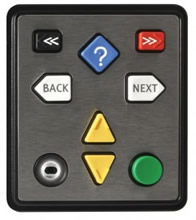The US Department of Transport rules for accessibility

As part of the Air Carrier Access Act (ACAA) air travelers with disabilities may soon find it easier to navigate.
For the iPad generation a touch screen is an efficient and intuitive interface. However for those with impaired vision an encounter with a touch screen terminal presents a daunting challenge. Menus and options presented in an exclusively visual medium bar access to vital information and services.
New Department of Transport regulations come into force during 2016. The regulations will require that at least 25% of airport kiosks are equipped with audio navigation technology. Sight impaired airline customers and airport users will be assured access to information and services by connection of a personal headset via a jack plug socket. The customer receives an audible summary of the information and services presented on the kiosk’s visual display screen. A highly tactile keypad enables navigation through those audible menus and the subsequent selection of available options by a simple key press. Audio navigation technology will also help non-readers. Some agencies consider that an inability to read may be the world’s most common form of disability; regardless of whether such inability stems from physiological, educational, cultural or cognitive reasons.
The new regulations do allow for a traditional keyboard to be used as the tactile navigation device. However many kiosk manufacturers have chosen to install devices designed specifically to assist those with sensory or mobility impairment.
The new ACAA rules have inspired a new generation of assistive devices that challenge traditional keypad design. Innovative use of shape, color, texture and illumination have made audio navigation a more intuitive and rewarding experience. The British company Storm Interface has pioneered the use of integral illumination to identify and group features by function. As an example; they located bright white LEDs within the jack plug socket. This illumination, combined with a highly tactile indented surface, made the socket much easier to find by those with low vision or no vision. Some of these assistive keypads are also designed for operation using a head-stick or easy-grip stylus.
Storm Interface worked with the Trace Center and the Royal National Institute of Blind People to better understand how keypad technology can be adapted and enhanced to improve accessibility. These adaptations of the simple keypad are now appearing in the latest ATMs and kiosks, delivering significant improvements in accessibility for all users.
The DOT, the American aviation industry and those kiosk manufacturers leading this evolution should be applauded and supported in their endeavor. “It is not just a matter of compliance, it’s also good business”, says Gregg Vanderheiden Director, Trace Research Center.
Background Information:
Storm Interface is an award winning, UK based, manufacturer of human interface devices. The Storm range of secured, sealed and toughened data entry devices are laboratory tested and field proven. They are constructed to survive in the most demanding applications and environments. Since 1986, Storm’s design, technology and manufacturing quality have established Storm products as the industry standard for durability and reliability.
For more information, visit www.storm-interface.com
Download as document:
150717_Accessibility_MediaRelease.docx
← Back